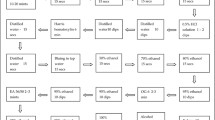Abstract
Purpose
Despite their wide use, the limits of presumptive tests can be poorly understood. The aim of this study was to investigate the specificity and sensitivity of conventional, as well as innovative, presumptive tests for blood, semen and saliva.
Methods
We investigated Kastle–Meyer (KM) and leucomalachite green (LMG) tests for blood with regard to their sensitivity and specificity in the presence of oxidizing (hypochlorite) and anti-oxidizing (ascorbic acid) agents. The suitability and specificity of the red starch paper (RSP) test for saliva was assessed. Finally, the inhibitory effect of detergent on the acid phosphatase (AP) test for semen was investigated along with possible cross reactions to tea stains.
Results
Our results confirm previous findings of higher sensitivity and specificity of the KM test compared to LMG test for blood. Contrary to previous studies, no statistically significant difference was observed in the sensitivity of the tests between dry and wet stains. The novel RSP test was found to successfully detect saliva. We demonstrated that acid phosphatase (AP) testing for semen is possible on used RSP. A common multipurpose detergent had an inhibitory effect on AP tests. False positive results were obtained from tea stains. Testing different sorts of tea (black, green and herbal teas) revealed that only Camellia varieties produce positive result with the AP test, due to AP being present in the plants.
Conclusions
From our results we conclude that specific knowledge of each test, including substances that may affect the test outcome, is imperative to ensure correct interpretation of presumptive test results.


Similar content being viewed by others
References
Kastle JH, Shedd OM. Phenolphthalin as a reagent for the oxidizing ferments. Am Chem J. 1901;26:526.
Meyer E. Beiträge zur Leukocytenfrage. Münchner Medizinische Wochenschrift. 1903;50:1489–93.
Cox M. A study of the sensitivity and specificity of four presumptive tests for blood. J Forensic Sci. 1991;36:1503–11.
Kind SS. The use of the acid phosphatase test in searching for seminal stains. J Crim Law Criminol Police Sci. 1957;47:597–600.
Tobe SS, Watson N, Daéid NN. Evaluation of six presumptive tests for blood, their specificity, sensitivity, and effect on high molecular-weight DNA. J Forensic Sci. 2007;52:102–9.
Grodsky M, Wright K, Kirk PL. Simplified preliminary blood testing-an improved technique and a comparative study of methods. J Crim Law Criminol Police Sci. 1951;42:95–104.
Hooft PJ, van de Voorde HP. Interference of body products, food and products from daily life with the modified zinc test and the acid phosphatase test. Forensic Sci Int. 1994;66:187–96.
Tirimanna AS. Acid phosphatases in the tea leaf. Experientia. 1972;28:633.
Martin NC, Clayson NJ, Scrimger DG. The sensitivity and specificity of red-starch paper for the detection of saliva. Sci Justice. 2006;46:97–105.
Hedman J, Dalin E, Rasmusson B, Ansell R. Evaluation of amylase testing as a tool for saliva screening of crime scene trace swabs. Forensic Sci Int Genet. 2011;5:194–8.
Bright JA, Cockerton S, Harbison S, Russell A, Samson O, Stevenson K. The effect of cleaning agents on the ability to obtain DNA profiles using the Identifiler™ and PowerPlex® Y multiplex kits. J Forensic Sci. 2011;56:181–5.
Sackiewicz A, Niemcunowicz-Janica A, Pepiński W, Skawrońska M, Szeremeta M, Ptaszyńska-Sarosiek I, Okłota M. Evaluation of visualization of biological stains with the use of alternative light source (ALS) for the purpose of genetic identification. Part II. Semen samples analysis. Arch Med Sadowej Kryminol. 2010;60:258–62.
Haas C, Hanson E, Ballantyne J. Capillary electrophoresis of a multiplex reverse transcription-polymerase chain reaction to target messenger RNA markers for body fluid identification. Methods Mol Biol. 2012;830:169–83.
Gršković B, Zrnec D, Vicković S, Popović M, Mršić G. DNA methylation: the future of crime scene investigation? Mol Biol Rep. 2013;40:4349–460.
Acknowledgments
The authors thank all students of the Forensic Science postgraduate classes of 2010/2011 and 2011/2012 for their outstanding laboratory work. We also thank Nicola McCallum for excellent technical assistance.
Author information
Authors and Affiliations
Corresponding author
Rights and permissions
About this article
Cite this article
Vennemann, M., Scott, G., Curran, L. et al. Sensitivity and specificity of presumptive tests for blood, saliva and semen. Forensic Sci Med Pathol 10, 69–75 (2014). https://doi.org/10.1007/s12024-013-9515-6
Accepted:
Published:
Issue Date:
DOI: https://doi.org/10.1007/s12024-013-9515-6




